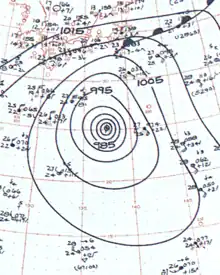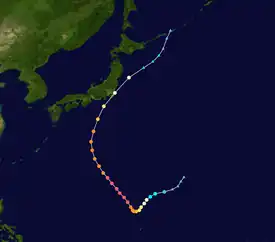Typhoon Violet (1961)
Typhoon Violet was an unusually intense super typhoon that made landfall in Japan in early October 1961. It was the second strongest typhoon of the year with wind speeds up to 205 mph, which made Violet the third strongest tropical cyclone in terms of 1 minute sustained winds, Just behind Typhoon Nancy in the same year and Hurricane Patricia in 2015.
 Typhoon Violet near peak intensity on October 8 | |
| Meteorological history | |
|---|---|
| Formed | October 2, 1961 |
| Dissipated | October 10, 1961 |
| Category 5-equivalent super typhoon | |
| 1-minute sustained (SSHWS/JTWC) | |
| Highest winds | 335 km/h (205 mph) |
| Lowest pressure | 895 hPa (mbar); 26.43 inHg |
| Overall effects | |
| Fatalities | 2 confirmed |
| Areas affected | Japan |
Part of the 1961 Pacific typhoon season | |
Meteorological history

Tropical storm (39–73 mph, 63–118 km/h)
Category 1 (74–95 mph, 119–153 km/h)
Category 2 (96–110 mph, 154–177 km/h)
Category 3 (111–129 mph, 178–208 km/h)
Category 4 (130–156 mph, 209–251 km/h)
Category 5 (≥157 mph, ≥252 km/h)
Unknown
Violet was first observed as a small circulation to the southwest of Marcus Island. On October 2, the system had organized enough to warrant further investigation. After a few days of observation, a report of tropical storm force winds was relayed back to the JTWC and on October 4, it was upgraded to Tropical Storm Violet. Violet took an unusual track, moving in a southern direction after formation. This was due to its location west of a high-pressure system, which the storm struggled to move around. After completing a curve to the south of the ridge, Violet quickly intensified into a typhoon. The movement of the subtropical ridge to the east resulted in Violet turning abruptly to the northwest. Violet continued to intensify and soon reached its peak intensity, on October 7, with sustained winds of 205 mph (330 km/h) and a minimal surface pressure of 886 hPa (26.2 inHg);[1] however, the wind readings during this era of reconnaissance were erroneously high. Violet moved in a smooth path northward and clipped the Boso Peninsula area of Japan, near Tokyo. After landfall, Violet began to transition into an extratropical cyclone and continued to move northward. By October 10, Violet had become fully extratropical.[2]
Impact


Violet was an intense storm, yet did not impact any landmass at or near peak intensity. On Guam, damages were light, mostly consisting of crop damage. The effects on Japan were generally minimal due in part to early preparation. A 9124-ton freighter, The Pioneer Muse, was left stranded on the Daitō Islands during the passing of the typhoon on October 9. All men on board were saved and later the cargo of military hardware was scavenged.[3] Another ship, The Sheik, also was stranded a few miles from The Pioneer Muse, it would later break in two due to rough seas. Two fatalities were reported in Japan due to the passage of Violet.[2]
See also
References
- National Climatic Data Center (2013). "Violet IBTrACS File". National Oceanic and Atmospheric Administration. Retrieved June 14, 2013.
- Joint Typhoon Warning Center (1962). "Annual Typhoon Report 1961" (PDF). United States Navy. Retrieved April 2, 2013.
- Rosendal, Hans (January 1962). "Mariners Weather Log". Six (one). United States Weather Bureau: 24.
{{cite journal}}: Cite journal requires|journal=(help)